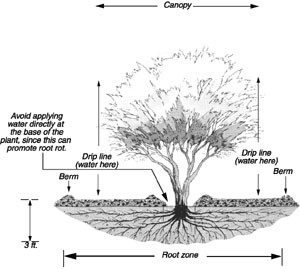Winter Watering, Pruning, and Landscape Assessment

Watering
Watering in the winter is essential to tree and shrub health in our high desert landscapes. In order for most established landscape trees and shrubs to flourish in our climate, you must deep water them at least once per month in the donut feeding root zone. Continue this deep watering schedule through the end of April, at which time you will need to increase the watering schedule to two times per month. An exception to this rule is newly planted trees that need to be watered more frequently during the first year of their life. Another exception is the watering of native and highly xeric plants, which respond to less frequent watering.
times per month. An exception to this rule is newly planted trees that need to be watered more frequently during the first year of their life. Another exception is the watering of native and highly xeric plants, which respond to less frequent watering.
Choose a sunny 50 degree winter day (when the ground is not frozen) to do your monthly watering. Thoroughly water the donut root feeding zone surrounding your tree or shrub. The feeding roots of the tree and shrub are located in an outer donut shaped zone surrounding your tree. The inner circumference of the tree donut zone starts at the drip-line or canopy location of the outer branches and extends at least two radial feet to the outer circumference. The creation of an outer circumference earth or rock berm will help to prevent water runoff from this zone. The method is to water the entire tree donut zone slowly and thoroughly from the top of soil down so that the water gradually seeps down to a depth of ~24 inches. Arborists will advise on going down to 30 inches to provide the best moisture support base. Smaller shrubs need only be watered to a depth of 12 inches. The use of a soaker hose wrapped around the donut zone of the tree or shrub is ideal for this type of watering. Or, strategically place the end of a standard watering hose taking advantage of gravity to distribute slow flowing water evenly around the tree’s feeding root zone. Re-position the hose end periodically to achieve even watering around the donut zone.
The time needed to achieve the proper tree watering depth depends on the composition of your landscape soil. The typical soil composition for Rio Rancho homes is high in sand content. The water should soak in rather quickly unless your topsoil lies on a caliche layer. If the water is not soaking in quickly the watering may have to be done in stages to allow the water to soak deeply without run-off. Depth of water in soil may be measured by a hand push probe meter found in your local hardware store. Or, make an intuitive decision on the time required to achieve deep tree and shrub watering based on working with your gar-den soil in the past.
While you are deep  watering, assess the need for re-placing com-post and mulch around your trees and shrubs. The layering of 1-2” of cured compost in direct contact with the soil followed by a 2-3” top layer of organic mulch (wood chips or pecan shells) will help to build up organic matter in the top layer of your soil and prevent moisture evaporation.
watering, assess the need for re-placing com-post and mulch around your trees and shrubs. The layering of 1-2” of cured compost in direct contact with the soil followed by a 2-3” top layer of organic mulch (wood chips or pecan shells) will help to build up organic matter in the top layer of your soil and prevent moisture evaporation.
If trees are located in a windy area a shallow loose rock layer may serve as a protective covering for the compost layer.
Do not bunch up the compost and mulch around the tree trunk. The trunk area should be free of organic matter to avoid creating a medium for moisture and pest growth.
Pruning:
A friend of mine in Placitas uses Super Bowl Sunday as a starting time to prune her trees and shrubs. Rio Rancho has a slightly warmer climate compared to Placitas, and residential properties provide even more opportunities for sheltered areas or micro-climates. So you may start pruning dormant shrubs and deciduous trees right now.
Again, take advantage of one of the warmer winter days to walk your landscape and visualize your dormant deciduous trees and shrubs. This is the best time to sculpt your trees (i.e. Ash, Hackberry, Chinese Pistache, ornamental Pear and Plum) and large shrubs (i.e. New Mexico Olive, Smoke Tree) to work toward achieving an eye appealing and healthier shape for your plant. A good start is to eliminate crossing branches.
Always cut back to the branch, twig or bud that is pointing in the direction that you want the tree or shrub to grow using a clean well sharpened pruning shear or saw. For branches that originate from the trunk of the tree you will see a collar that originates from the trunk at the junction of the branch. Avoid cutting into this collar because it contains vascular tissue important to the overall health of the tree. The branch pruning cut should be made right outside of the collar without leaving a branch stub. For larger branches make successive cuts to the branch to eliminate weight prior to the final cut to remove the stub close to the collar.
Branches that form a shallow or “V”-shaped crotch angle present a week structural point to the tree, and they are trickier to remove. If no branch collar is evident at the crotch angle start the pruning cut at the lowest point of the undesirable
branch, and cut at a 30 degree angle toward the top point of the branch connection to the trunk.
Clean your pruning tool between cuts with a cloth soaked in rubbing alcohol or a spray of di-lute bleach solution (10%) to avoid spreading possible plant disease be-tween cuts. Proceed slowly and make wise choices in pruning cuts on your tree or large shrub. When in doubt, leave the branch and hold off pruning it until the following year. Do not remove more than 15- 20% of the living branches of a tree or large shrub per year, and never top a tree. Pruning should be started on young trees and practiced conservatively every year to achieve the desired shape of the tree. Dead branches may be pruned from a tree or shrub at any time of the year. The pruned tree or shrub will heal during the remainder of the dormant season and be ready to focus all of its energy into the remaining branches for a robust spring bud break.
The pruning of pine trees and shrubs can be held off until late February or just prior to the spring pollination. The pruning of fruit orchard trees can be held off until late February and March depending on your orchard’s micro-climate and the type of fruit tree. Follow the same approach to pruning deciduous trees and shrubs as described above with some minor variations. Master Gardeners can provide more detailed information on the pruning of all tree and shrub varieties.
Xeric plants such as butterfly, sage, spirea and chamisa bushes and native grasses can be pruned down to 1/3 of their original height in late February or March to allow for new spring growth. I typically delay the pruning of these plants until very late winter, since the stalks and seed heads do provide winter interest to our high desert gardens. The seed pods for red elephant grass can be pruned from the evergreen plant in March.
Assessment:
Working in your garden in the winter is a perfect time to assess your need for spring and summer landscape plantings. If your garden appears lackluster at this time, research trees, shrubs and ground cover that provide winter interest with evergreen foliage, colorful berries and sculptural wood effects. Take a winter stroll at the Rio Rancho Water Wise Garden, maintained by the Master Gardeners, at 915 Pine Tree just behind the Esther Bone Memorial Library to get ideas on what trees, shrubs and ground cover appeal to you in the winter time.
